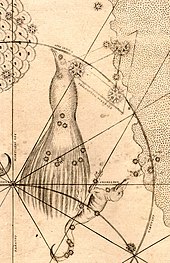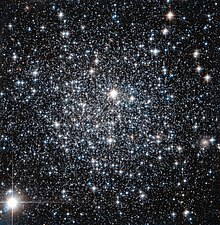Apus
| Constellation | |
67th) | |
| Main stars | 4 |
|---|---|
| Bayer/Flamsteed stars | 12 |
| Stars with planets | 2 |
| Stars brighter than 3.00m | 0 |
| Stars within 10.00 pc (32.62 ly) | 0 |
| Brightest star | α Aps (3.83m) |
| Messier objects | 0 |
| Meteor showers | 0 |
| Bordering constellations | Triangulum Australe Circinus Musca Chamaeleon Octans Pavo Ara |
| Visible at latitudes between +5° and −90°. Best visible at 21:00 (9 p.m.) during the month of July. | |
Apus is a small
The five brightest stars are all reddish in hue. Shading the others at apparent magnitude 3.8 is Alpha Apodis, an orange giant that has around 48 times the diameter and 928 times the luminosity of the Sun. Marginally fainter is Gamma Apodis, another aging giant star. Delta Apodis is a double star, the two components of which are 103 arcseconds apart and visible with the naked eye. Two star systems have been found to have planets.
History

Apus was one of twelve constellations published by
After its introduction on Plancius's globe, the constellation's first known appearance in a celestial atlas was in German cartographer
Characteristics
Covering 206.3 square degrees and hence 0.5002% of the sky, Apus ranks 67th of the
Features
Stars
Lacaille gave twelve stars Bayer designations, labelling them Alpha through to Kappa, including two stars next to each other as Delta and another two stars near each other as Kappa.[7] Within the constellation's borders, there are 39 stars brighter than or equal to apparent magnitude 6.5.[c][8] Beta, Gamma and Delta Apodis form a narrow triangle, with Alpha Apodis lying to the east.[12] The five brightest stars are all red-tinged, which is unusual among constellations.[13]
Alpha Apodis is an
The fifth-brightest star is Zeta Apodis at magnitude 4.8,[13] a star that has swollen and cooled to become an orange giant of spectral type K1III, with a surface temperature of 4649 K and a luminosity 133 times that of the Sun.[18] It is 300 ± 4 light-years distant.[14] Near Zeta is Iota Apodis, a binary star system 1,040 ± 60 light-years distant,[14] that is composed of two blue-white main sequence stars that orbit each other every 59.32 years. Of spectral types B9V and B9.5 V, they are both over three times as massive as the Sun.[24]
Eta Apodis is a white main sequence star located 140.8 ± 0.9 light-years distant.[14] Of apparent magnitude 4.89, it is 1.77 times as massive, 15.5 times as luminous as the Sun and has 2.13 times its radius. Aged 250 ± 200 million years old, this star is emitting an excess of 24 μm infrared radiation, which may be caused by a debris disk of dust orbiting at a distance of more than 31 astronomical units from it.[25]
Two star systems have had exoplanets discovered by doppler spectroscopy, and the substellar companion of a third star system—the sunlike star HD 131664—has since been found to be a brown dwarf with a calculated mass of the companion to 23 times that of Jupiter (minimum of 18 and maximum of 49 Jovian masses).[30] HD 134606 is a yellow sunlike star of spectral type G6IV that has begun expanding and cooling off the main sequence.[31] Three planets orbit it with periods of 12, 59.5 and 459 days, successively larger as they are further away from the star.[32] HD 137388 is another star—of spectral type K2IV—that is cooler than the Sun and has begun cooling off the main sequence.[31] Around 47% as luminous and 88% as massive as the Sun, with 85% of its diameter, it is thought to be around 7.4 ± 3.9 billion years old.[33] It has a planet that is 79 times as massive as the Earth and orbits its sun every 330 days at an average distance of 0.89 astronomical units (AU).[34]
Deep-sky objects

The Milky Way covers much of the constellation's area.[36] Of the deep-sky objects in Apus, there are two prominent globular clusters—NGC 6101 and IC 4499—and a large faint nebula that covers several degrees east of Beta and Gamma Apodis.[37] NGC 6101 is a globular cluster of apparent magnitude 9.2 located around 50,000 light-years distant from Earth,[38] which is around 160 light-years across. Around 13 billion years old, it contains a high concentration of massive bright stars known as blue stragglers, thought to be the result of two stars merging.[39] IC 4499 is a loose globular cluster in the medium-far galactic halo;[40] its apparent magnitude is 10.6.[41]
The galaxies in the constellation are faint.
See also
Notes
- ^ While parts of the constellation technically rise above the horizon to observers between the 7°N and 22°N, stars within a few degrees of the horizon are to all intents and purposes unobservable.[8]
- ^ Delporte had proposed standardising the constellation boundaries to the International Astronomical Union, who had agreed and gave him the lead role.[10]
- ^ Objects of magnitude 6.5 are among the faintest visible to the unaided eye in suburban-rural transition night skies.[11]
References
- ^ Entry in Oxford English Dictionary, (OED Third Edition, November 2010).
- ^ a b c d Ridpath, Ian. "Apus". Star Tales. Retrieved 10 April 2012.
- ^ a b c "Apus, constellation boundary". The Constellations. International Astronomical Union. Retrieved 14 February 2014.
- ^ a b Ridpath, Ian. "Johann Bayer's Southern Star Chart". Star Tales. self-published. Retrieved 30 May 2016.
- ^ a b Ley, Willy (December 1963). "The Names of the Constellations". For Your Information. Galaxy Science Fiction. pp. 90–99.
- ^ Ridpath, Ian. "Frederick de Houtman's Catalogue". Star Tales. self-published. Retrieved 30 May 2016.
- ^ ISBN 978-0-939923-78-6.
- ^ a b c d Ridpath, Ian. "Constellations: Andromeda–Indus". Star Tales. self-published. Retrieved 26 August 2015.
- Bibcode:1922PA.....30..469R.
- ^ Ridpath, Ian. "Constellation boundaries: How the modern constellation outlines came to be". Star Tales. self-published. Retrieved 1 June 2016.
- ^ Bortle, John E. (February 2001). "The Bortle Dark-Sky Scale". Sky & Telescope. Archived from the original on 31 March 2014. Retrieved 26 August 2015.
- ISBN 978-1-4481-2691-0.
- ^ ISBN 978-0-7503-0654-6.
- ^ .
- ^ ISBN 978-0-691-17788-5.
- ^ Kaler, James B. (6 April 2007). "Alpha Aps". Stars. University of Illinois. Retrieved 30 March 2016.
- S2CID 425754.
- ^ S2CID 118665352.
- .
- ISBN 978-1-4614-7648-1.
- ^ Watson, Christopher (25 August 2009). "Delta1 Apodis". The International Variable Star Index. American Association of Variable Star Observers. Retrieved 30 March 2016.
- S2CID 15358380.
- Bibcode:1975mcts.book.....H.
- .
- S2CID 51417657.
- .
- S2CID 56041336. See table 1, IRAS 14003-7633.
- ^ Watson, Christopher (25 August 2009). "NO Apodis". The International Variable Star Index. American Association of Variable Star Observers. Retrieved 31 March 2015.
- S2CID 59060842. A77.
- S2CID 54986291.
- ^ S2CID 119476992.
- S2CID 8130257. 91.
- S2CID 54555839.
- S2CID 119192207. Archived from the originalon 2015-05-29. Retrieved 2016-05-29.
- ^ "IC 4499: A globular cluster's age revisited". ESA/Hubble Picture of the Week. Retrieved 5 August 2014.
- ISBN 978-1-85233-709-4.
- ^ ISBN 978-0-522-87124-1.
- ^ ISBN 978-1-4614-4750-4.
- ISBN 978-0-521-82796-6.
- .
- ^ Frommert, Hartmut. "IC 4499". Students for the Exploration and Development of Space. Retrieved 22 April 2012.
External links
